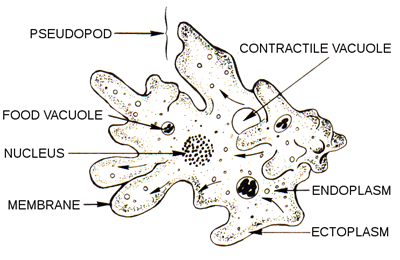PDF chapter test TRY NOW
The organisation of life starts from the atom and extends to the biosphere. In the middle, we have several stages, which filled with both living and non-living things. Here, the basic fundamental unit of life is a cell. They are microscopic, and they carry all the essential functions in living organisms.
Cell is the basic structural and functional unit of organism. And, organisms that are made up of a single cell are called unicellular organisms.
Example:
Amoeba, Paramecium, Euglena, Chlamydomonas, algae, and fungus - Saccharomyces (yeast).
Organisms that are made up of many cells are known as multicellular organisms.
Example:
Fishes, frog, reptiles, lizards, birds and humans.
Unicellular organisms:
They are microscopic, and cannot be seen with the naked eye. They are mostly aquatic, primitive and simplest of all the animals. These organisms perform physiological activities by structures present inside the body of the organisms called the organelles.
Amoeba:
Unicellular organism that is mostly present in ponds, aslow-moving river , and lakes. It does not have any definite shape. It performs all the activities like digestion, respiration, locomotion and reproduction.
- Amoeba swallows food present in the water, and digestion takes place in the food vacuole.
- Contractile vacuoles helps in the excretion.
- Respiration is through simple diffusion that takes place through the body surface.
- Amoeba has pseudopodia that are finger-like projections that aids in locomotion or movement. Pseudopodia is also called a false foot.
The cytoplasm can be seen as 2 layers – the outer ectoplasm and the inner endoplasm. The cell membrane is double-layered, and the amoeba has a nucleus and nucleolus.

Amoeba
It is also a unicellular organism that is lives in aquatic habitats. It is typically a slipper-shaped or oblong organism that is covered with hairy structures called the cilia. Paramecium locomotes with the help of these short hair-like structures called cilia.

Paramecium
Euglena:
Euglena is photosynthetic unicellular organisms that are present in freshwater and saltwater. They have both animal and plant characteristics.
Euglena moves using a flagellum which is a whip-like tail. Euglena produces food through the process of photosynthesis through the organelle chloroplast.

Euglena
Reference:
https://commons.wikimedia.org/wiki/File:Amoeba_(PSF).svg
